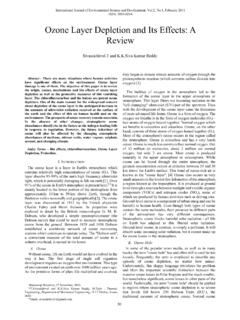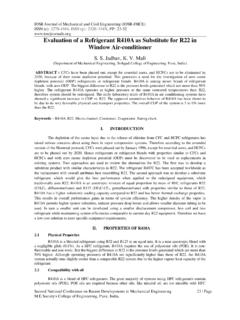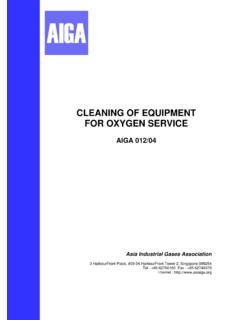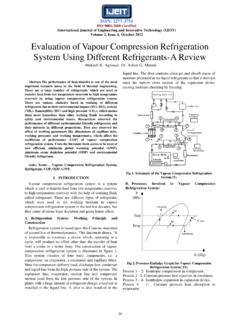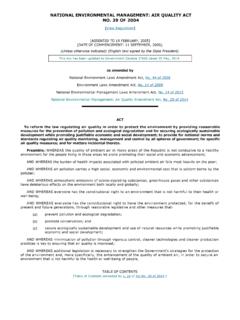Transcription of Hydrofluoroalkane as a propellant for pressurized …
1 4411. Doctoral student, Graduate Program in Pediatrics, Universidade Federalde Minas Gerais (UFMG), Belo Horizonte, MG, Coordinator, Center of Respiratory Diseases, School of Medicine,Universidade Federal da Bahia (UFBA), Salvador, BA, Full professor, Department of Pediatrics, School of Medicine and Head ofthe Pediatric Pulmonology Unit, Hospital das Cl nicas, UniversidadeFederal de Minas Gerais (UFMG), Belo Horizonte, MG, received Mar 22 2004, accepted for publication Mar 31 citation: Ibiapina CC, Cruz AA, Camargos PA. Hydro-fluoroalkane as a propellant for pressurized metered-dose inhalers:history, pulmonary deposition, pharmacokinetics, efficacy and safety.
2 JPediatr (Rio J). 2004;80 : To review the literature about Hydrofluoroalkane as a propellent of pressurized metered-dose inhalerscontaining anti-asthma of data: Bibliographic search in electronic databases (MEDLINE, MDConsult, HighWire, Medscape andLILACS) and direct search referring to the past 15 years, using the key words Hydrofluoroalkane , asthma and childhoodwere carried of the findings: 43 original articles on the replacement of clorofluorcarbon by hydrofluoralkane wereselected. Hydrofluoralkane showed to be a safe propellent, with pulmonary deposition ranging from 50 to 60%, andto have significant efficacy, when compared with placebo (p < ) in controlled clinical trials.
3 Most works usinghydrofluoralkane included beclomethasone diproprionate. Approximate annual cost of a treatment with beclomethasonediproprionate/hydrofluoral kane was lower than with beclomethasone diproprionate/clorofluorcarbon. Some studiesassessed salbutamol, fluticasone, flunisolide and the association fluticasone-salmeterol, with hydrofluoralkane aspropellent in pressurized metered-dose : Efficacy and safety of hydrofluoralkane as propellent of bronchodilators and inhaled corticosteroidsin adults was evidenced, as well as, in general, there was a better pulmonary deposition of particles. However,literature data on the use of hydrofluoralkane in the paediatric age group are still scarce and further studies withchildren and adolescents would be of great Pediatr (Rio J).
4 2004;80(6):441-6: Asthma, hydrofluoralkane, treatment, de PediatriaCopyright 2004 by Sociedade Brasileira de PediatriaREVIEW ARTICLEH ydrofluoroalkane as a propellantfor pressurized metered-dose inhalers:history, pulmonary deposition, pharmacokinetics,efficacy and safetyC ssio C. Ibiapina,1 lvaro A. Cruz,2 Paulo A. M. Camargos3 IntroductionInhalation, used ever since medicine exists, becamevery popular in the late 19th century. At that time,medications were put in boiling water so that patientscould inhale their the specialized 20th-century literature, the firstreports on aerosol therapy for the treatment of asthmadata back to the 1950s, when pressurized metered-doseinhalers (pMDI) were introduced, representing anundeniable improvement in the treatment of respiratorydisorders.
5 At present time, it is widely known that theprescription of pMDI exceeds 500 million units a year ona worldwide basis, and that their use has been increasingdecade after corticosteroids are regarded as first-linetreatment, recommended in every consensus for themanagement of persistent asthma, and often are deliveredvia a pMDI. Chlorofluorocarbon (CFC) is the most widelyused propellant in pMDI; it is inexpensive, safe and efficient,but its use has been universally restricted due to itsdeleterious effects on the ozone first evidence that CFC and other chlorine-containingproducts contribute to ozone layer depletion was gatheredin the Because of these substances, the ultravioletradiation that reaches the Earth s surface is increased,producing severe adverse effects on man, such as skincancer, cataract and lower immunological resistance.
6 Birds,sea life, plastic and other materials also are Jornal de Pediatria - Vol. 80, , 2004 Hydrofluoroalkane as a propellant for inhalers Ibiapina CC et aliiThe hole in the ozone layer formed over Antarctica,observed in the early 1980s, has been expanding everyyear. Recent studies have estimated its size as being aslarge as 23 million square meters, which corresponds tonearly three times the size of international agreement, known as the MontrealProtocol,5 which aimed to control the production andconsumption of substances that can cause ozone depletion,was signed in September1987. The agreement establisheda 50% reduction in CFC production per year until 1998.
7 In1990, due to the ample evidence regarding CFC and ozonelayer depletion, an amendment banned the manufactureof CFC fire extinguishers from the year 2000 onwards. In1992, as ozone layer depletion worsened, CFC productionwas prohibited until late 1995, being only allowed inmedications until 2005. Thus, pMDI are the only exceptionto CFC production and consumption, since they wereconsidered essential to the treatment of 1995, two safe and efficient propellants Hydrofluoroalkane 134a (HFA 134 a) and hydrofluoroalkane227ea (HFA 227ea) were acknowledged by the In 1996, the Food and Drug Administration (FDA)approved the use of HFA 134a in does not affect the ozone layer, but it exerts asignificant effect on global warming, as it is one of the sixgreenhouse effect 1997, the United Nations Framework Convention onClimate Change the Kyoto Protocol approved theresolutions of the Earth Summit that took place in Rio in1992.
8 The Kyoto protocol expanded those resolutions,placing heavy emphasis on the emission of greenhouseeffect gases in the USA. Of note, although the Kyoto Protocolwas signed by 55 countries, including industrialized ones, itwas not ratified by the United States, and therefore it doesnot have the force of law in its ,6 The Kyoto Protocol devised mechanisms for themanagement of climate changes, especially with regard tothe reduction in the production of gases that can causeglobal warming. The six greenhouse effect gases (carbondioxide, methane, nitric oxide, Hydrofluoroalkane ,perfluorocarbon and sulfur hexafluoride) were gatheredinto a single group.
9 This approach gives countries moreflexibility to choose the percentage of reduction for eachgas, so that they can achieve the total reduction goalestablished by the , along with sulfur hexafluoride andperfluorocarbons, have a large heat-generating , as they account for only of the greenhouseeffect gases emitted in the USA, their contribution toglobal warming is ,7 The use of HFA in pMDI is a medical option withenormous value to health; therefore, every nation shouldguarantee its availability to the population. Given thisCFC/HFA transition period, the aim of this review is todiscuss the aspects related to the pharmacokinetics,efficacy, safety and use of HFA in the treatment ofasthmatic of beclomethasone dipropionate andCFC- and HFA-containing pMDIThe CFC/HFA transition resulted in the development ofaerosol technology.
10 Beclomethasone dipropionate (BDP),the oldest type of inhaled corticosteroid, has been used inasthma treatment for over two decades. The combination ofBDP and HFA 134a results in an aerosol with much smallerparticles than those produced by CFC inhalers. Mathematicalmodels that relate particle size with the site of deposition inthe respiratory tract and experimental upper airway modelsdemonstrate that the particles produced by HFA have anenhanced small-airway deposition, whereas those particlesproduced by CFC tend to have a more proximal deposition,also in the pMDI and powder inhalers release thedrug, which is first deposited in the oropharynx and then inthe large airways.










